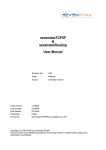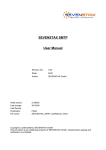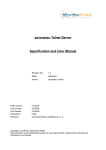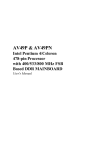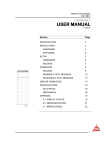Download TFTP Specification and User Manual
Transcript
sevenstax Trivial File Transfer Protocol
Specification and User Manual
Initial version:
Last change:
Last Review:
Publication:
Filename:
Revision No.:
2.1
State:
Released
Author:
sevenstax GmbH
21/08/07
14/01/08
14/01/08
Public
sevenstaxTFTP_UserManual_v21
Copyright (c) 2008 by sevenstax GmbH
This document is an intellectual property of sevenstax GmbH. Unauthorized copying and
distribution is prohibited.
TFTP Specification and User Manual
Table of Contents
1 Introduction............................................................................................................ 3
2 Using TFTP............................................................................................................. 3
2.1
2.2
2.3
2.4
2.5
User modes.................................................................................................................... 3
Initialization.....................................................................................................................3
Using as Client............................................................................................................... 4
Using as Server..............................................................................................................4
Using as Client + Server................................................................................................ 4
3 Internal Data Structures........................................................................................ 4
3.1 TFTP_DATA_TYPE structure........................................................................................ 4
4 Public Functions.................................................................................................... 5
4.1
4.2
4.3
4.4
4.5
4.6
stxTFTP_Init ( handler )................................................................................................. 5
stxTFTP_Start ( ServerClient )....................................................................................... 5
stxTFTP_Stop ( )............................................................................................................ 6
stxTFTP_Tick ( ).............................................................................................................6
stxTFTP_WriteData ( remote_ip_address, szFilename, eTFTPType).......................... 7
stxTFTP_Read ( remote_ip_address, szFilename, eTFTPType )................................. 7
5 Notifycodes............................................................................................................ 9
5.1
5.2
5.3
5.4
5.5
5.6
5.7
5.8
NC_TFTP_GETDATA ( TFTP_DATA_TYPE, block-number )...................................... 9
NC_TFTP_RECV ( TFTP_DATA_TYPE, block-number )........................................... 9
NC_TFTP_REQ_WRITE ( TFTP_DATA_TYPE, TransferMode )............................. 10
NC_TFTP_REQ_READ ( TFTP_DATA_TYPE, TransferMode )............................... 10
NC_TFTP_RX_READY................................................................................................10
NC_TFTP_RX_ERROR............................................................................................... 11
NC_TFTP_TX_READY................................................................................................ 11
NC_TFTP_TX_ERROR............................................................................................... 11
6 Adjustable Parameters........................................................................................ 11
7 Restrictions.......................................................................................................... 12
8 Change History.................................................................................................... 13
File: sevenstaxTFTP_UserManual_v21.odt
Revision No.: 2.1
Page 2 / 13
printed 14/01/08
Public
TFTP Specification and User Manual
1 Introduction
TFTP is a very simple Protocol used to transfer files via UDP. sevenstaxTFTP is part of
inside the sevenstax Internet Protocols Suite.
It can be enabled via #define TFTP_SUPPORTED = 1 in features.h. The TFTP protocol
works ahead UDP, so UDP_SUPPORTED = 1 must be set too.
For basic information on how to use the sevenstax Internet Protocols Suite, please refer to
the sevenstaxTCP/IP Users Manual.
2 Using TFTP
The Trivial File Transfer Protocol is used to transmit data between a client and a server. It is
a very simple and small protocol and therefore it can easily be implemented in embedded
systems with small resources.
2.1 User modes
The module works in three different modes:
–
Client-Mode
–
Server-Mode
–
Client+Server-Mode
In Client-Mode the device is able to send Read-Requests (RRQ) and Write-Requests
(WRQ), but it can't receive them. The device sends the request from a random UDP-Port.
In Server-Mode the device is able to answer RRQ and WRQ. The default port to receive
requests is UDP-Port 69.
In Client + Server-Mode it is possible to do both, sending and receiving RRQ and WRQ. The
UDP-Port to receive the request is the same as in Server-Mode and the port to send them is
also random as in Client-Mode.
To use TFTP with sevenstaxTCP/IP you should proceed the following way (please refer to
the following chapters for details):
2.2 Initialization
●
#define TFTP_SUPPORTED =1 in 'features.h'. Also UDP_SUPPORTED must be
enabled there.
●
The application has to prepare a dedicated callback function, to react Notify Codes in
of the TFTP module.
●
Call stxTFTP_Init() once to set-up sevenstaxTFTP's internal state and to register the
applications callback function.
File: sevenstaxTFTP_UserManual_v21.odt
Revision No.: 2.1
Page 3 / 13
printed 14/01/08
Public
TFTP Specification and User Manual
●
In your main loop or operating system task call stxTFTP_Tick() repeatedly
to keep it alive.
2.3 Using as Client
●
To start the module in Client-Mode, call: stxTFTP_Start( TFTP_MODE_CLIENT ).
Now the Module is able to send Requests.
●
To get a file from a remote TFTP server, use the function stxTFTP_ReadData( ).
●
To transmit data to a TFTP server, use the function stxTFTP_WriteData( ).
2.4 Using as Server
●
To start the module in Server-Mode call: stxTFTP_Start(TFTP_MODE_SERVER ).
Now the Module is able to receive Requests (RRQ and WRQ) on the defined Port
(default: 69).
●
The server will automatically respond to remote read / write requests.
●
The server will automatically call the user application, if it requires or delivers any
user data.
2.5 Using as Client + Server
●
To start the module in Client-Server-Mode call: stxTFTP_Start(
TFTP_MODE_CLIENTSERVER )
●
In this mode the module is able to receive on the defined port and to send on a
random port.
3 Internal Data Structures
3.1 TFTP_DATA_TYPE structure
The TFTP_DATA_TYPE structure is used to hold information about incoming and outgoing
data packets.
It delivers information from application to the TFTP module about of the data to be send. It
delivers information from the TFTP module to the application about of the data to being
received.
File: sevenstaxTFTP_UserManual_v21.odt
Revision No.: 2.1
Page 4 / 13
printed 14/01/08
Public
TFTP Specification and User Manual
typedef struct _tag_tftp_senddata
{
IPV4 FPTR_stx
dest_ip_address;
CHAR_stx
szFilename[TFTP_MAX_FILENAME_SIZE];
UINT8_stx FPTR_stx
fpData;
UINT16_stx
wSize;
} TFTP_DATA_TYPE;
//
//
//
//
IP-Address of the remote
Filename of RRQ or WRQ
Pointer to the data
data size (max. 512 bytes)
IPV4 FPTR_stx dest_ip_address
Pointer to an IPV4 address structure containing the IP-Address of the remote peer.
Please refer to the “sevenstaxTCP/IP Users Manual” for details.
CHAR_stx
szFilename [ TFTP_MAX_FILENAME_SIZE ]
File name of RRQ or WRQ.
FPTR_stx
fpData
Pointer to the data delivered / received.
UINT16_stx
wSize
Amount of data in bytes (max. 512 bytes, <512 means 'End Of File').
4 Public Functions
4.1 stxTFTP_Init ( handler )
Description
Set up some internal variables and registers the application callback function. It must
be called once before using any other TFTP functions.
Parameter
PROTOCOL_NOTIFY_HANDLER handler
Application handler function to receive notify codes from sevenstaxTFTP module. The
handler function will be called, when TFTP data is received, TFTP data should be
send, to inform the application about an error or that a transfer has been finished
successful.
Return Value
void
Comment
-
4.2 stxTFTP_Start ( ServerClient )
Description
This function starts the module in “Server”, “Client” or “Client + Server” mode,
depending on the delivered parameter.
File: sevenstaxTFTP_UserManual_v21.odt
Revision No.: 2.1
Page 5 / 13
printed 14/01/08
Public
TFTP Specification and User Manual
Parameter
TFTP_MODE ServerClient
Via Parameter ServerClient TFTP module starts in different modes:
If ServerClient is TFTP_MODE_CLIENT, the device is able to get data from or
put data to a TFTP server.
If ServerClient is TFTP_MODE_SERVER, the device is able to receive data
from or submit data to clients.
If ServerClient is TFTP_MODE_CLIENTSERVER, the device is server and
client.
Return Value
void
Comment
stxTFTP_Init() must have been called before using this function.
Please note, that the module supports only one TFTP session at a time, a server OR
client session. The session first must be closed, before switching to the other mode.
4.3 stxTFTP_Stop ( )
Description
This function stops the current mode of the device, therefore data can´t be exchanged
anymore.
Parameter
void
Return Value
void
Comment
stxTFTP_Start() must have been called before using this function.
Please note, that there is no need stop the session, to switch between server and
client mode, if it was initialized with TFTP_MODE_CLIENTSERVER mode.
4.4 stxTFTP_Tick ( )
Description
This function keeps TFTP alive. It should repeatedly be called by the application, like
all other sevenstax “Tick” functions too, independently of TFTP is stopped or not.
Parameter
void
Return Value
void
File: sevenstaxTFTP_UserManual_v21.odt
Revision No.: 2.1
Page 6 / 13
printed 14/01/08
Public
TFTP Specification and User Manual
Comment
This function will not consume application runtime, if no TFTP session is active.
4.5 stxTFTP_WriteData ( remote_ip_address, szFilename, eTFTPType)
Description
Forces the TFTP-module to send a Write-Request to a remote TFTP-Server. If the
request is accepted, the notify-handler will be called with the notifycode
NC_TFTP_GETDATA.
Parameter
IPV4 remote_ip_address
Target's IP-Address
STRING_stx szFilename
Case sensitive filename used by the opponent to store the transmitted data.
UINT8_stx eTFTPType
Type of transfer mode: TFTP_TRFM_OCTET only (TFTP_TRFM_NETASCII not yet
supported)
Return Value
BOOL_stx
TRUE_stx
FALSE_stx
if Request has been sent
if any error occurs
Comment
stxTFTP_Start() must have been called with TFTP_MODE_CLIENT or
TFTP_MODE_CLIENTSERVER before using this function. It is not possible to send a
write-request in Server-Mode (TFTP_MODE_SERVER).
Please note, that the file name will be handled case sensitive!
4.6 stxTFTP_Read ( remote_ip_address, szFilename, eTFTPType )
Description
Forces the TFTP module to send a Read-Request to a remote TFTP-Server.
If the request is accepted, the notify-handler will be called with the notifycode
NC_TFTP_RECV.
Parameter
IPV4 remote_ip_address
Target's IP-Address.
STRING_stx szFilename
Case sensitive name of the file requested from the remote server.
UINT8_stx eTFTPType
Type of transfer mode: TFTP_TRFM_OCTET only (TFTP_TRFM_NETASCII not yet
supported)
Return Value
BOOL_stx
File: sevenstaxTFTP_UserManual_v21.odt
Revision No.: 2.1
Page 7 / 13
printed 14/01/08
Public
TFTP Specification and User Manual
TRUE_stx
FALSE_stx
if Request has been sent
if any error occurs
Comment
stxTFTP_Start( ) must have been called with TFTP_MODE_CLIENT or
TFTP_MODE_CLIENTSERVER before using this function. It is not possible to sends
a read-request in Server-Mode (TFTP_MODE_SERVER).
Please note, that the file name will be handled case sensitive!
File: sevenstaxTFTP_UserManual_v21.odt
Revision No.: 2.1
Page 8 / 13
printed 14/01/08
Public
TFTP Specification and User Manual
5 Notifycodes
This is a list of notifycodes generated by sevenstaxTFTP.
Notifycodes inform the user application about any event generated by a sevenstax module.
For details regarding the use of the notify-handler, please refer to the “sevenstaxTCP/IP
Users Manual“.
5.1 NC_TFTP_GETDATA ( TFTP_DATA_TYPE, block-number )
This event is generated by the TFTP module to get a user data from the application, to be
sent as the next data block.
Therefore, the application must set the pointer to the beginning of the next 0..(max.) 512
bytes block of data and set the data size.
The same block might be requested multiple times, if the TFTP module detected errors (e.g.
lost packets). That´s why it is necessary to observe the block-number. The datapointer
position can be calculated by block-number * 512.
Parameter a points to a TFTP_DATA_TYPE structure, which contains the remote IPAddress, the requested file name, a data pointer and the data size. The pointer must be set
to the expected data and the data size must be set to the right size (maximal 512 bytes) .
Parameter b indicates the block number of the data, which is requested.
ReturnValue indicates if the application result:
TFTP_ERR_OK
if accepted by application
TFTP_ERR_xxx
if any application problem
A TFTP_ERR_xxx will result in sending the adequate TFTP error message to the remote
station.
5.2 NC_TFTP_RECV ( TFTP_DATA_TYPE, block-number )
This event is generated by the TFTP module to deliver the next data block to the user
application.
The TFTP_DATA_TYPE includes a pointer to the received data-block. The block number
indicates the position of the received data. The file offset position can be calculated by blocknumber * 512.
Parameter a points to the TFTP_DATA_TYPE structure. The structure contains the remoteIP-Address, the file-name, a datapointer and the data-size. The datapointer points to the
received data and the size of the data is given by the data-size.
Parameter b indicates the block number of the received data.
ReturnValue indicates the application result:
TFTP_ERR_OK
if accepted by application
TFTP_ERR_DISKFULL
if any application error
File: sevenstaxTFTP_UserManual_v21.odt
Revision No.: 2.1
Page 9 / 13
printed 14/01/08
Public
TFTP Specification and User Manual
5.3 NC_TFTP_REQ_WRITE ( TFTP_DATA_TYPE, TransferMode )
This event notifies the application for an incoming Write-Request.
The TFTP_DATA_TYPE includes the filename to write (only in Server- or Client-ServerMode) and the remote-IP-Address. The application has to decide, weather to accept the
request or not.
Parameter a points to a TFTP_DATA_TYPE structure, which contains the remote IPAddress and the file name. The data pointer and the data size is not used by this event.
Parameter b indicates the transfer mode ( octett or netascii ). Netascii is not supported in
this version.
ReturnValue indicates the application result:
TFTP_ERR_OK
TFTP_ERR_ACCESS_VIOLATION
TFTP_ERR_DISKFULL
TFTP_ERR_ILLEGAL_OPERATION
TFTP_ERR_FILE_ALREADY_EXISTS
Please note, that any authentication or access right management might be solved by the
user application at this time.
5.4 NC_TFTP_REQ_READ ( TFTP_DATA_TYPE, TransferMode )
This event notifies the application of an incoming Read-Request.
The TFTP_DATA_TYPE includes the name of the file requested by the client (only in Serveror Client-Server-Mode).
Parameter a points to a TFTP_DATA_TYPE structure, which contains the remote IPAddress and the filename. The datapointer and the datasize is not used by this event.
Parameter b indicates the transfer mode ( octet or netascii ). netascii is not supported in this
version.
ReturnValue indicates the application result:
TFTP_ERR_OK
TFTP_ERR_FILE_NOT_FOUND
TFTP_ERR_ACCESS_VIOLATION
TFTP_ERR_ILLEGAL_OPERATION
5.5 NC_TFTP_RX_READY
This event notifies the application that the current receive transfer finished successfully.
Parameter a, b and ReturnValue are not used.
File: sevenstaxTFTP_UserManual_v21.odt
Revision No.: 2.1
Page 10 / 13
printed 14/01/08
Public
TFTP Specification and User Manual
5.6 NC_TFTP_RX_ERROR
This event notifies the application that the current receive transfer was aborted with an error.
Parameter a, b and ReturnValue are not used.
5.7 NC_TFTP_TX_READY
This event notifies the application that the current transmit transfer finished successfully.
Parameter a, b and ReturnValue are not used.
5.8 NC_TFTP_TX_ERROR
This event notifies the application that the current transmit transfer was aborted with an
error.
Parameter a, b and ReturnValue are not used.
6 Adjustable Parameters
TFTP parameters are defined in 'tftpdefs.h'. These parameters should properly be adjusted
depending on the application requirements. The following list describes them in detail.
TFTP_SERVERPORT_LOCAL
default: 69
valid: 1..n
RFC conform UDP-Port to listen for requests (for server-mode/client-server-mode).
Might be adopted to special user requirements.
TFTP_SERVERPORT_REMOTE
default: 69
valid: 1..n
RFC conform Remote UDP-Port to connect to (for client-mode/client-server-mode).
Might be adopted to special user requirements.
TFTP_MAX_FILENAME_SIZE
default: 60
valid: 1..n
Buffer size to handle filenames of read/write requests. Might be adopted to users file
system or memory requirements.
File: sevenstaxTFTP_UserManual_v21.odt
Revision No.: 2.1
Page 11 / 13
printed 14/01/08
Public
TFTP Specification and User Manual
7 Restrictions
As sevenstaxTFTP is developed for very tiny embedded applications, there are a few
restrictions, which must considered. The restrictions result from the requirement, to run on
very small devices with a small amount of RAM/ROM resources:
Only one TFTP session at a time
sevenstaxTFTP can only be used for one single session, as client or server.
Further remote client connection trials will silently be ignored. User application tries to
open a client session while a session already is active, will return error code.
'octet' / 'binary' mode supported only
sevenstaxTFTP currently supports 'octet' (might also be called 'binary') mode only.
This is a raw binary transfer, which can be used for ASCII files too. Using the 'octet'
mode helps to avoid target system specific conversion problems.
Receiving 'netascii' read/write request by the server will result in sending error
messages to the remote client. User application calls using the 'netascii' will result in
error return codes.
File: sevenstaxTFTP_UserManual_v21.odt
Revision No.: 2.1
Page 12 / 13
printed 14/01/08
Public
TFTP Specification and User Manual
8 Change History
Ver.
Date
by
Change description
1.0
21-08-2007
bbr base version
2.0
08-01-2008
ttu
2.1
14-02-2008
krz review
review, source-code changes considered
The information furnished in this document is believed to be accurate and reliable. However,
no responsibility is assumed by sevenstax for its use, nor for any infringements of patents or
other rights of third parties resulting from its use. No license is granted under any patents or
patent rights of sevenstax.
This document is an intellectual property of sevenstax GmbH. Unauthorized copying and
distribution is prohibited.
Copyright (c) 2008 by sevenstax GmbH
File: sevenstaxTFTP_UserManual_v21.odt
Revision No.: 2.1
Page 13 / 13
printed 14/01/08
Public













